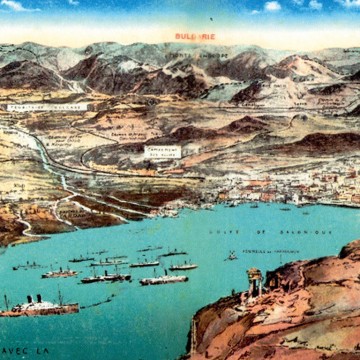The name
The origin and historical evolution of Kalamaria’s name remains a mystery, but it looks pretty likely that the toponym first appeared in the Byzantine period. Professor G. Theocharidis (Αντιλεγόμενο τοπωνύμιο-Διάφορες απόψεις για την Καλαμαριά) claims that “Kalamaria” is a compound composed of the Byzantine words skala (quay of the naval base in the area of Cape Emvolo) and meria (a medieval form of meros, i.e. location or site). Gradually, the two words combined and evolved to the present state, i.e. Kalamaria.
Older sources partially confirm Theocharidis’ argument. The French scholar and diplomat Esprit Marie Cousinéry (1747-1833), who served as Consul General in Thessaloniki for two decades (1773-1793), also argued that Kalamaria is a corrupt form of Kalameria but believed that the original meaning of the toponym was “beautiful place” (beaux lieu).
A more romantic version associates the word’s origin with Mara, daughter of the Serbian Despot Đurađ Branković (1377-1456) and Eirene Kantakouzene (1400-1457). In September 1435, at the age of seventeen, Mara was betrothed to the Ottoman Sultan Murad II in an attempt to prevent an invasion of Serbia from the Ottoman Empire. After the Sultan’s death, in February 1451, Mara joined a local monastery and earned the locals’ respect, who called her Kale Mara (Mara the Good). The corruption of these words gave rise to the toponym. It is evident, though, that this theory is incorrect because the place name was in use for many centuries before the birth of Mara Branković (1418-1487).
The place-name first appeared in the Middle Byzantine period. In the early 10th century, there was a gate in the eastern walls of Thessaloniki that was known as “Kassandreotiki” because it gave access to the road to Kassandreia in Chalkidiki. John Kaminiates, who was a Greek resident of Thessalonica when the Arabs sacked the city in 904, mentions this gate in his account of the city’s plunder, On the capture of Thessalonica (Εις την άλωσιν της Θεσσαλονίκης). A few years later, chroniclers refer to the doorway as the “Gate of Kalamaria” because an area outside the city walls was known by that name.
The toponym Kalamaria is securely attested in 1083 on documents of the Xenophontos monastery that refer to an area to the southeast of Thessaloniki surrounded by water on two of its three sides. Three centuries later, Kalamaria is frequently mentioned in various monasterial documents from Athos. The word also appears in patriarchal documents of the Ottoman period.


